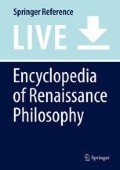Abstract
Renaissance hydrostatics developed almost independently from other fields of mechanics. Through all the Middle Ages and early Renaissance, only the main results of Archimedes’ fundamental work On Floating Bodies were known and substantially accepted, with no attention of their theoretical foundations. The gradual rediscovery of Archimedean texts (through apocryphal texts and Latin translations) gave new life to the speculations on the equilibrium of fluids and the laws of flotation. A key figure in Renaissance hydrostatics is Leonardo da Vinci. Although he never accessed Archimedes’ treatise, some Archimedean notions can be found in his manuscripts, where a qualitative approach to hydraulic problems led him to a sort of mechanical demonstration of the distribution of hydrostatic pressure on a vertical surface. It was only after the publication of print editions of Archimedes’ work that hydrostatics found a new and more sound theoretical framework, with the work of Simon Stevin. His rejection of perpetual motion and the hypothesis of a water “stiffening” which does not affect equilibrium within the liquid body allowed him to generalize Archimedes’ law of flotation, demonstrate the hydraulic paradox, and formulate the basic law which describes hydrostatic pressure on a submerged surface.
References
Arredi, Filippo. 1943. Le origini dell’idrostatica. Roma: Scuola Tipografica Pio X.
Cavagnero, Paolo, and Roberto Revelli. 2014. The weight of water. Physics Today 67(8): 41–46.
Clagett, Marshall. 1959. The science of mechanics in the middle ages. Madison: University of Wisconsin Press.
Clagett, Marshall. 1969. Leonardo da Vinci and the medieval archimedes. Physis: Rivista Internazionale di Storia della Scienza 11: 100–151.
Clagett, Marshall, and Ernest Moody. 1960. The medieval science of weights (Scientia de Ponderibus): Treatises ascribed to Euclid, Archimedes, Thabit Ibn Qurra, Jordanus de Nemore, and Blasius of Parma. Madison: University of Wisconsin Press.
Devreese, Joseph, and Guido Vanden Berghe. 2008. Magic is no magic – The wonderful world of Simon Stevin. Southampton: WIT Press.
Dijksterhuis, Eduard. 1987. Archimedes. Princeton: Princeton University Press.
Duhem, Pierre. 1906–1909. Études sur Léonard de Vinci: Ceux qu’il a lus et ceux qui l’ont lu. Paris: Hermann.
Fassò, Costantino. 1987. The birth of hydraulics during the Renaissance period. In Hydraulics and hydraulic research: A historical review, ed. Günther Garbrecht. Rotterdam: A. A. Balkema.
Fassò, Costantino. 1997. Leonardo e l’idraulica del Rinascimento. In Che chosa è acqua: atti del simposio su Leonardo da Vinci e l’idraulica, 141–225. Milano: Libri Scheiwiller.
Gille, Bertrand. 1964. Les ingénieurs de la Renaissance. Hermann: Parigi.
Leggatt, Stuart. 1995. On the heavens I and II. Warminster: Aris & Phillips.
Macagno, Enzo. 1987. La nocion de presion en la mecanica de fluidos vinciana. Raccolta Vinciana 22: 239–263.
Mach, Ernst. 1897. Die Mechanik in ihrer Entwickelung: historisch-kritisch Dargestellt. Leipzig: F. A. Brockhaus.
Marinoni, Augusto. 1973–1980. Il Codice Atlantico di Leonardo da Vinci: edizione in facsimile dopo il restauro dell’ originale conservato nella Biblioteca Ambrosiana di Milano. Firenze: Giunti Barbera.
Marinoni, Augusto. 1987–1990. I manoscritti dell’ Institut de France. Firenze: Giunti Barbera.
Munson, Bruce. 2002. Fundamentals of fluid mechanics. New York: Wiley.
Nordon, Marcel. 1992. Histoire de l’hydraulique II – L’eau démontrée. Paris: Masson.
Pedretti, Carlo. 1978. The codex atlanticus of Leonardo da Vinci: A catalogue of its newly restored sheets. New York: Johnson. Reprint Corp and Harcourt Brace Jovanovich.
Pedretti, Carlo. 1987. The codex hammer of Leonardo da Vinci. Firenze: Giunti Barbera.
Author information
Authors and Affiliations
Corresponding author
Editor information
Editors and Affiliations
Section Editor information
Rights and permissions
Copyright information
© 2016 Springer International Publishing AG
About this entry
Cite this entry
Cavagnero, P. (2016). Hydrostatics. In: Sgarbi, M. (eds) Encyclopedia of Renaissance Philosophy. Springer, Cham. https://doi.org/10.1007/978-3-319-02848-4_932-1
Download citation
DOI: https://doi.org/10.1007/978-3-319-02848-4_932-1
Received:
Accepted:
Published:
Publisher Name: Springer, Cham
Print ISBN: 978-3-319-02848-4
Online ISBN: 978-3-319-02848-4
eBook Packages: Springer Reference Religion and PhilosophyReference Module Humanities and Social SciencesReference Module Humanities
Publish with us
Chapter history
-
Latest
Hydrostatics in Renaissance Sciences- Published:
- 01 April 2020
DOI: https://doi.org/10.1007/978-3-319-02848-4_932-2
-
Original
Hydrostatics- Published:
- 03 February 2017
DOI: https://doi.org/10.1007/978-3-319-02848-4_932-1

